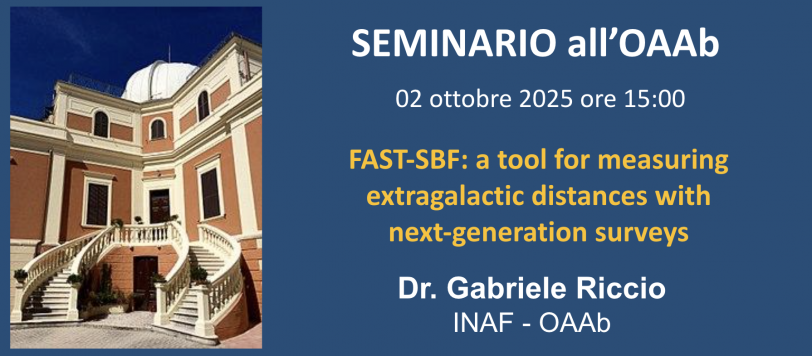Categories: News Seminari
Tags: Ammassi di galassie Cosmologia fluttuazioni di brillanza superficiale Popolazioni Stellari Rubin-LSST Scala delle distanze cosmologiche
Posted by: Eleonora Ferroni
Date: Set 27, 2025
FAST-SBF: a tool for measuring extragalactic distances with next-generation surveys

Giovedì 02 ottobre alle ore 15:00, il Dott. Gabriele Riccio, dell’INAF-Osservatorio Astronomico d’Abruzzo, terrà il seminario dal titolo “FAST-SBF: a tool for measuring extragalactic distances with next-generation surveys”.
Abstract:
A precise determination of the distance is essential for deriving nearly all key physical properties of cosmic structures and objects, including their mass, luminosity, and size. In the last decades, achieving increasingly precise distance measurements has become crucial to resolve one of the most debated issues in modern cosmology: the “Hubble tension”. This tension refers to the discrepancy between the expansion rate of the universe measured through local distance indicators and the value inferred from the cosmic microwave background under the assumption of the $\Lambda$CDM cosmological model. Whether this discrepancy originates from the way we measure distances or from limitations of the cosmological model can be clarified by improving the accuracy of our distance measurements. Only a few distance indicators can achieve the required precision. Among them, one which offers both the broad applicability necessary to resolve the depth of galaxy clusters out to the Hubble flow and the capability to be applied to a significant fraction of galaxies within the same environment is the surface brightness fluctuation method (SBF). Due to its characteristics, this method represents one of the few, if not the only, distance indicators capable of consistently providing distances for the vast number of galaxies that the forthcoming Legacy Survey of Space and Time (LSST) will observe. In this talk, I will present the first results from FAST-SBF, a new pipeline designed for the measurement of the SBF signal, specifically developed to meet the speed and automation requirements necessary to handle the enormous datasets that LSST will provide.






Comments are closed.